Common redshank
- Common redshank
- https://linnuriik.ee/wp-content/uploads/2021/09/Punajalg-tilder_DSC_7333-2-s-1024x682.jpg
- Keemu linnud
- https://linnuriik.ee/wp-content/uploads/2021/09/punajalg-tilder_salvestusVRunnel.mp3
Common redshank, Photo: Peter Lind
Tutvustus
Estonian Punajalg-tilder
Also known as: redshank
Status in Estonia
Breeding and migratory bird.
Description
The legs and base of the beak are red, the top side is brownish, the chest is striped, the sides are spotted, there is a bright ring around the eye and short eyebrow stripe. During flight, the wide white trailing edge of the wing and the white oblong-triangular preen gland area are visible. In the summer, adult birds have thick, slightly irregular specks and streaks on both the top and undersides; however, in the winter, the top side and breast area are brownish-grey.
Size
Body length 24–27 cm, wingspan 47–53 cm, body mass 92–127 g.
Similar species
Spotted redshank, marsh sandpiper, ruff.
Distribution
The common redshank breeds practically throughout Europe, locally in North Africa and is also widely spread in Asia (Himalayas, Tibetan Plateau, Mongolia, North China, Amur River valley). Its breeding grounds stretch up to 70 degrees north latitude in Fennoscandia and Karelia, but not beyond 60 degrees north latitude in Western Russia or 55 degrees north latitude in the Urals of Western Siberia. The population of Western Europe and North Africa winters mainly in Northwestern Europe, on the Black Sea and Caspian coasts, in the Mediterranean countries, from the Middle East to West Africa and also in East Africa and the Arabian Peninsula. Only a small portion of the species crosses the equator; in South Africa, it is already rare. The eastern population winters in South India, Sri Lanka, Southeast Asia and the Greater and Lesser Sunda Islands. It is common in Estonia depending on the availability of suitable breeding sites.
Population
Estonia has 2500–3500 breeding pairs.
Occurrence in Estonia
It arrives in late March to early April. The migration of northern populations begins in August and lasts until mid-September.
Diet
It feeds on invertebrates, which it catches by picking them out of the mud or digging with its beak.
Habitat
The common redshank is an open landscape wader that breeds mostly in beach meadows in Estonia. It is also found in open bogs and low marshes, inland lakes, river gorges and meadows, grassy areas of low-water quarry lakes, watery meadows, etc.
Nesting
It builds its nest on the ground. A sheltered hollow under or adjacent to taller plants is typically chosen as the nest site. Both adult birds help build the nest: the male bird builds the bottom, while the female bird lines it with long dry straw. It is generally loyal to the nest, nesting in the same location/area for multiple years. In April to May, the female bird lays 3–5 yellow eggs with chestnut-brown spots, which both parents incubate for 22–25 days. Around a day after hatching, the chicks leave the nest and begin hunting for food on their own. Initially, both parents care for the chicks, but a few weeks after hatching, the female bird abandons the male bird and the chicks. The male bird stays with the chicks until they are 25–35 days old and capable of flying. In rare cases, the parents are separated in such a way that some of the chicks are nurtured by the mother bird and others by the male bird.
Conservation status and protection
It belongs to the protected species of category III. The biggest threat is the destruction and degradation of nesting habitats and migrating stopovers. Enemies in the air include big birds of prey, primarily falcons. On the ground, foxes and small predators pose a threat.
Distribution and population in Lääne County
Common redshanks are common migratory and breeding birds in Lääne County. They prefer to be along the shores of Matsalu in areas with well-maintained beach meadows. The common redshank can also be seen in flood-meadows and bogs in Lääne County.
This bird species is common in Matsalu and may be observed at Põgari-Sassi beach meadow and Haeska and Keemu birdwatching towers.
